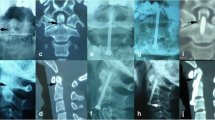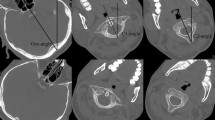Abstract
Introduction
Posterior C1–C2 pedicle screw fixation is a reliable technique used in treatment of type II odontoid fracture. However, the loss of cervical range of rotation motion (RORM) was inevitable. There were few studies focusing on the influence of short-term C1–C2 fixation with nonfusion technique to preserve cervical function in patients younger than 60 years. The purpose of this study was to compare cervical RORM which was measured by an improved goniometer, and the clinical outcomes between short-term and long-term C1–C2 fixation techniques in the treatment of Grauer type 2B and 2C odontoid fracture.
Materials and methods
This study represents a retrospective analysis, including patients who underwent primary C1–C2 fixation surgery. These patients were divided into short-term and long-term groups based on whether underwent a fixation removal operation. The clinical results were collected and compared between the two groups. Independent T test and Chi-square analyses were used to identify significant differences between the two groups and dependent T test was used within each group. Statistical significance was set at p < .05.
Results
There were no severe postoperative complications, and all 60 patients achieved spinal stabilization after primary surgery. The mean rotation angle in the short-term group at last follow-up time was 138.39 ± 21.06°, which was better than 83.59 ± 13.06° in the long-term group (p < .05). The same statistical difference was observed in flexion–extension angle, which was 71.11 ± 18.73° in short-term group and 53.34 ± 18.23° in long-term group. The mean NDI score in short-term group at last follow-up time was 1.23 ± 0.86 and better than 8.24 ± 3.17 in long-term group. However, the VAS score in short-term group was 1.82 ± 0.54 which was worse compared to 0.64 ± 0.29 in long-term group.
Conclusions
The results demonstrated that primary C1–C2 fixation with nonfusion technique could support satisfactory clinical effects. In addition, the removal of instruments after bony fusion could improve the function of cervical movement significantly in patients under 60 years.




Similar content being viewed by others
Data availability
All data are fully available without restriction.
Abbreviations
- ACSF:
-
Anterior cannulated screws fixation
- RORM:
-
Range of rotation motion
- NDI:
-
Neck disability index
- VAS:
-
Visual analog scale
- CT:
-
Computer tomography
- MRI:
-
Magnetic resonance imaging
- AAD:
-
Atlantoaxial dislocation
References
Anderson LD, D’Alonzo RT (1974) Fractures of the odontoid process of the axis. J Bone Jt Surg Am 56(8):1663–1674
Subach BR, Morone MA, Haid RW Jr, McLaughlin MR, Rodts GR, Comey CH (1999) Management of acute odontoid fractures with single-screw anterior fixation. Neurosurgery 45(4):812–819 ((discussion 819-820))
Apfelbaum RI, Lonser RR, Veres R, Casey A (2000) Direct anterior screw fixation for recent and remote odontoid fractures. J Neurosurg 93(2 Suppl):227–236
Ochoa G (2005) Surgical management of odontoid fractures. Injury 36(Suppl 2):B54-64. https://doi.org/10.1016/j.injury.2005.06.015
Tan M, Wang H, Wang Y, Zhang G, Yi P, Li Z, Wei H, Yang F (2003) Morphometric evaluation of screw fixation in atlas via posterior arch and lateral mass. Spine 28(9):888–895. https://doi.org/10.1097/01.BRS.0000058719.48596.CC
Koller H, Resch H, Acosta F, Zenner J, Schwaiger R, Tauber M, Forstner R, Lederer S, Auffarth A, Hitzl W (2010) Assessment of two measurement techniques of cervical spine and C1–C2 rotation in the outcome research of axis fractures: a morphometrical analysis using dynamic computed tomography scanning. Spine (Phila Pa 1976) 35(3):286–290. https://doi.org/10.1097/BRS.0b013e3181c911a0
Andersson S, Rodrigues M, Olerud C (2000) Odontoid fractures: high complication rate associated with anterior screw fixation in the elderly. Eur Spine J Off Publ Eur Spine Soc Eur Spinal Deform Soc Eur Sect Cerv Spine Res Soc 9(1):56–59
Mazur MD, Mumert ML, Bisson EF, Schmidt MH (2011) Avoiding pitfalls in anterior screw fixation for type II odontoid fractures. Neurosurg Focus 31(4):E7. https://doi.org/10.3171/2011.7.FOCUS11135
Chen ZD, Wu J, Lu CW, Zeng WR, Huang ZZ, Lin B (2020) C1–C2 pedicle screw fixation for pediatric atlantoaxial dislocation: initial results and long-term follow-up. J Pediatr Orthop 40(2):65–70. https://doi.org/10.1097/BPO.0000000000001111
Menger RP, Storey CM, Nixon MK, Haydel J, Nanda A, Sin A (2015) Placement of C1 pedicle screws using minimal exposure: radiographic, clinical, and literature validation. Int J Spine Surg 9:43. https://doi.org/10.14444/2043
Lin JM, Hipp JA, Reitman CA (2013) C1 lateral mass screw placement via the posterior arch: a technique comparison and anatomic analysis. Spine J 13(11):1549–1555. https://doi.org/10.1016/j.spinee.2013.06.006
Zarro CM, Ludwig SC, Hsieh AH, Seal CN, Gelb DE (2013) Biomechanical comparison of the pullout strengths of C1 lateral mass screws and C1 posterior arch screws. Spine J 13(12):1892–1896. https://doi.org/10.1016/j.spinee.2013.06.015
Fensky F, Kueny RA, Sellenschloh K, Puschel K, Morlock MM, Rueger JM, Lehmann W, Huber G, Hansen-Algenstaedt N (2014) Biomechanical advantage of C1 pedicle screws over C1 lateral mass screws: a cadaveric study. Eur Spine J Off Publ Eur Spine Soc Eur Spinal Deform Soc Eur Sect Cerv Spine Res Soc 23(4):724–731. https://doi.org/10.1007/s00586-013-3143-4
Theologis AA, Deviren V, Tay B (2017) Temporary fusionless posterior occipitocervical fixation for a proximal junctional type II odontoid fracture after previous C2-pelvis fusion: case report, description of a new surgical technique, and review of the literature. Eur Spine J Off Publ Eur Spine Soc Eur Spinal Deform Soc Eur Sect Cerv Spine Res Soc 26(Suppl 1):243–248. https://doi.org/10.1007/s00586-017-5093-8
Guo Q, Deng Y, Wang J, Wang L, Lu X, Guo X, Ni B (2016) Comparison of clinical outcomes of posterior C1–C2 temporary fixation without fusion and C1–C2 fusion for fresh odontoid fractures. Neurosurgery 78(1):77–83. https://doi.org/10.1227/NEU.0000000000001006
Yuan S, Wei B, Tian Y, Yan J, Xu W, Wang L, Liu X (2018) Posterior temporary C1–2 fixation for 3-part fractures of the axis (odontoid dens and Hangman fractures). Medicine 97(48):e12957. https://doi.org/10.1097/MD.0000000000012957
Zhong D, Lee G, Liao Y, Wang Q (2017) Is it feasible to treat odontoid fractures via primary posterior reduction and fixation without fusion? World Neurosurg 106:693–698. https://doi.org/10.1016/j.wneu.2017.06.115
Ni B, Guo Q, Lu X, Xie N, Wang L, Guo X, Chen F (2015) Posterior reduction and temporary fixation for odontoid fracture: a salvage maneuver to anterior screw fixation. Spine 40(3):E168-174. https://doi.org/10.1097/BRS.0000000000000709
Kaesmacher J, Schweizer C, Valentinitsch A, Baum T, Rienmuller A, Meyer B, Kirschke JS, Ryang YM (2017) Osteoporosis is the most important risk factor for odontoid fractures in the elderly. J Bone Miner Res 32(7):1582–1588. https://doi.org/10.1002/jbmr.3120
Molinari RW, Dahl J, Gruhn WL, Molinari WJ (2013) Functional outcomes, morbidity, mortality, and fracture healing in 26 consecutive geriatric odontoid fracture patients treated with posterior fusion. J Spinal Disord Tech 26(3):119–126. https://doi.org/10.1097/BSD.0b013e31823e99e4
Faure A, Graillon T, Pesenti S, Tropiano P, Blondel B, Fuentes S (2017) Trends in the surgical management of odontoid fractures in patients above 75 years of age: retrospective study of 70 cases. Orthop Traumatol Surg Res 103(8):1221–1228. https://doi.org/10.1016/j.otsr.2017.07.008
Butler JS, Dolan RT, Burbridge M, Hurson CJ, O’Byrne JM, McCormack D, Synnott K, Poynton AR (2010) The long-term functional outcome of type II odontoid fractures managed non-operatively. Eur Spine J Off Publ Eur Spine Soc Eur Spinal Deform Soc Eur Sect Cerv Spine Res Soc 19(10):1635–1642. https://doi.org/10.1007/s00586-010-1391-0
Platzer P, Thalhammer G, Sarahrudi K, Kovar F, Vekszler G, Vecsei V, Gaebler C (2007) Nonoperative management of odontoid fractures using a halothoracic vest. Neurosurgery 61(3):522–529. https://doi.org/10.1227/01.NEU.0000290898.15567.21 ((discussion 529-530))
Vernon H, Mior S (1991) The neck disability index: a study of reliability and validity. J Manipulative Physiol Ther 14(7):409–415
Giles LG, Muller R (2003) Chronic spinal pain: a randomized clinical trial comparing medication, acupuncture, and spinal manipulation. Spine 28(14):1490–1502 ((discussion 1502-1493))
Acknowledgements
There is no conflict of interest among all the authors.
Funding
This work was supported by Grants from Capital Characteristic Clinical project of Beijing Municipal Science and Technology Commission (https://www.bjkw.gov.cn/n8785584/index.html) (Grant no. Z161100000516009). No individuals employed or contracted by the funders played any role in study design, data collection and analysis, decision to publish, or preparation of the manuscript.
Author information
Authors and Affiliations
Contributions
MsT and PY conceived and designed the study. YS, LG, and XsT collected the data. JpS analyzed the data. JpS and YlW wrote the paper. FY and XsT reviewed and edited the manuscript. All the authors read and approved the manuscript.
Corresponding author
Ethics declarations
Conflict of interest
There were no competing interests existing among all the authors and institutions in our study.
Ethics approval and consent to participate
The study was approved by the Ethics Committee of China–Japan Friendship Hospital (belongs to National Health Commission of the People’s Republic of China) and was waived patients consent because of the nature of retrospective study.
Consent for publication
We have obtained consent to publish to report individual patient data (images).
Additional information
Publisher's Note
Springer Nature remains neutral with regard to jurisdictional claims in published maps and institutional affiliations.
Rights and permissions
About this article
Cite this article
Song, J., Yi, P., Wang, Y. et al. Short-term posterior C1–C2 pedicle screw fixation without fusion to treat type II odontoid fracture among people under 60 years. Arch Orthop Trauma Surg 142, 543–551 (2022). https://doi.org/10.1007/s00402-020-03641-x
Received:
Accepted:
Published:
Issue Date:
DOI: https://doi.org/10.1007/s00402-020-03641-x




